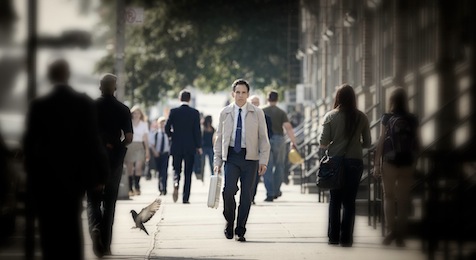“We only live once, Sergeant,” said Mitty, with his faint, fleeting smile. “Or do we?”
James Thurber’s 1939 short story “The Secret Life of Walter Mitty” was a snapshot of a Connecticut man going about a mundane set of errands, and, during the course of which, extrapolating elaborate fantasy scenarios with himself as the star. It became one of the classic works of American short fiction, and in fairly short order the name “Walter Mitty” became synonymous with “daydreamer.”
It was first adapted for the screen in 1947 with Danny Kaye in the lead, and now again with Ben Stiller directing and playing the lead.
Stiller’s Mitty is physically transplanted to the 21st century, even if his heart belongs to the 20th: he works as a “Negative Assets Manager” (maintaining physical film negatives) for a fictional version of LIFE magazine which is being taken over by a corporate transition team who intend to turn the publication into an online-only presence (akin to what happened to the real LIFE in 2009). Mitty spends his days pining for an attractive co-worker (Kristen Wiig), unsuccessfully attempting to send her “winks” on eHarmony. When Mitty’s sort-of-kind-of idol—ruggedly adventurous photograher Sean O’Connell (Sean Penn), so old school he doesn’t even have a phone and communicates with LIFE’s publishers via telegram—sends a negative reel and requests they use a specific photo for the magazine’s final cover, Mitty has to find the missing frame of celluloid, with the journey that entails comprising the movie’s narrative.
The Secret Life of Walter Mitty is a very well-directed movie, and a gorgeous one to look at, with Stiller’s choice to shoot on film echoing the protagonist’s affinity for analog technology—a nostalgic streak also reflected in the movie’s visual fascination with mid-20th century architecture and design, one of the two major informing influences on this Mitty’s daydreams. The original Mitty, living roughly within that time period himself, didn’t so much look back as he did escape. The 2013 incarnation also has personal reasons for looking back: he had to surrender his youth as a flamboyant skateboard prodigy after his father’s death to go to work and support his family. Thus, the second major influence on his daydreams: what his life could have been without the self-imposed rectitude of prematurely having to grow up.
The movie doesn’t so much take the stance that one doesn’t have to grow up, but that there is more than one way to do so. Stiller’s Mitty finds—repeatedly and not subtly—that safety is brief and illusory, but that it’s possible with a bit of effort to stay one step ahead of disaster, to have a rope around one’s waist before leaping into the void, so to speak. But the most important thing, and probably the most fundamental departure from Thurber’s Mitty, is that Stiller’s learns that fantasy—and, at a crucial point, its close relative memory—is key in informing one’s personal reality, in an “if you dream it, you can make it real” kind of way. Fantasy is what drives reality in the new version, instead of the other way around.
And that, rather than the misguided “things were better and purer then” nostalgia that frequently accompanies such narratives, is the point of the visual references to the post-WWII era in The Secret Life of Walter Mitty. It was an era whose mainstream pop culture, embodied by the real LIFE magazine, was defined by an optimism that today’s culture is not. The modern day in the movie is evoked with a slightly heavy and awkwardly humorous affect by references to commercial brands, which feels more thematically appropriate than most other product placement. Not to mention, the products in The Secret Life of Walter Mitty lead to sadness and futility; Mitty finds a better friendship with an eHarmony customer service rep (a terrific running gag) than he does romance while using the site.
There’s enough to appreciate in The Secret Life of Walter Mitty to make up for its not being, substantially, all that weighty, and for its occasional teetering on the precipice of earnestness over the void of treacle. It’s earnest and sweet in just the right proportions. Ben Stiller gives one of the more focused and least self-flagellating performances of his career. Kristen Wiig is funny and nice in very Kristen Wiig fashion. Shirley MacLaine and Kathryn Hahn are fun as mother and sister Mitty. There are a couple great cameos I won’t spoil, even if everyone else does. All in all it’s a pretty fantastic Hollywood movie, with lots of pretty fantasy. That it’s so well-built is really what elevates this above the mean for self-actualization movies, which tend to be a bit exasperating and pointless, particularly when they’re about rich and privileged men. This one’s not like that, though. This one’s very good indeed.
Danny Bowes is a film critic and columnist for RogerEbert.com and Indiewire. He also blogs sporadically. You can follow him on Twitter.










